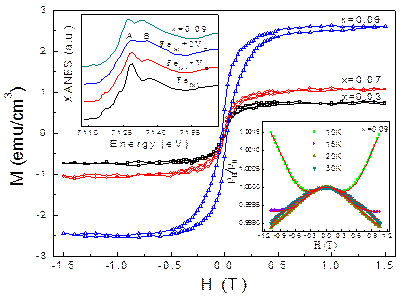| Oxygen Vacancy Induced Room Temperature Ferromagnetism and Magnetoresistance in Fe-Doped In2O3 |
| From: PublishDate:2016-06-03 Hits: |
Recently, spintronics with both the electronic charge and spin characteristic has become the research hot topics. If wishing to achieve the excellently spintronic devices, the preparation of dilute magnetic semiconductors (DMSs) with good room temperature ferromagnetism is important. In2O3 is a technologically important n-type wide band-gap (3.75eV) semiconductor with high electronic carrier concentration, mobility, high optical transparency and good gas sensing properties, and become a promising material for building spintronic devices. Moreover, the origin and mechanism of the observed ferromagnetism in In2O3 based DMSs is still under intense debate, especially for the correlation among the doped magnetic ions, carriers and structural defects (O vacancies or In interstitials). So, it is important to clarify the mechanisms responsible for the ferromagnetic order in In2O3-based DMSs. A team from Tianjin university of technology systematically investigated the local structures and electronic structures of doped Fe ions as well as the correlation with the structural defects, and further investigates the corresponding magnetic and transport properties in the Fe-doped In2O3 films. Their research has been published on March 15th, 2015 in the Journal of Physical Chemistry C.
The team prepared the Fe doped In2O3 films with good room ferromagnetism by RF-magnetron sputtering technique, and the saturated magnetization (Ms) increases monotonically with the increase of Fe concentration. The Fe-K edge XANES measurement carried out 4B9A-XRD station of BSRF as well as full multiple-scattering ab initio calculations reveal that Fe dopant atoms are substitutionally incorporated into In2O3 lattice with a mixed-valence (Fe2+/Fe3+) and form FeIn1+2VO complex with the O vacancy in the nearest coordination shell. The Mott variable range hopping (VRH) transport behavior dominates the conduction mechanism of the films at low temperature, confirming that the carriers are localized. The Fe doping has profound effects on the positive and negative MR contributions. The positive MR contribution becomes more pronounced with Fe doping, reflecting the occurrence of spin polarization and stronger s-d exchange interaction. The bound magnetic polarons (BMPs) associated with oxygen vacancy can be considered to play an important role in achieving the ferromagnetic order of the (In1-xFex)2O3 films. The relevant research can provide the importance scientific evidence for mediating the magnetic properties of DMSs and will be very helpful for the design and preparation of new type of spintronics devices. Article: Yukai. An*, Yuan. Ren, Dongyan. Yang, Zhonghua Wu, Jiwen. Liu*, Oxygen vacancy-induced room temperature ferromagnetismand magnetoresistance in Fe-doped In2O3 films, J. Phys. Chem. C 119 (2015) 4414-4421.
|
|
|
| Chinese
- Beamline 1W1 of BSRF started to runoperate in the couplingparasitic mode of BEPCII
- Synthesis of High Performance Polymer Materials for Field Effect-Transistors
- Surfactant molecular aggregates in green solvents
- GIXRD has played an important role in the characterization of organic thin-film transistors
Copyright © 2011 - 2012 Beijing Synchrotron Radiation Facility


